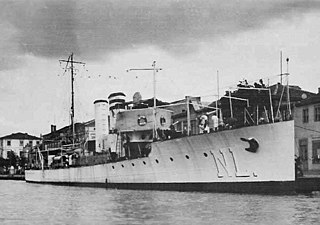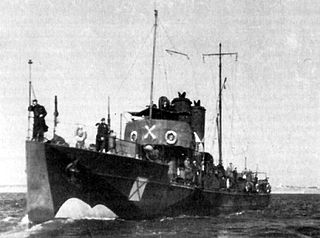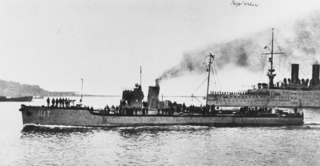 W
WNMS Năluca was a torpedo boat of the Royal Romanian Navy. She was commissioned in 1920, after initially serving as Tb 82 F in the Austro-Hungarian Navy during World War I. She and six more sister ships were awarded to Romania as reparations after the war ended.
 W
WSMS Natter was a torpedo boat of the Austro-Hungarian Navy. Natter was built by the German shipbuilder Schichau-Werke between 1895 and 1896. She was renamed Torpedoboot 18 in 1910 and used for local coast defence during the First World War. She was scrapped in 1920.
 W
WNMS Sborul was a torpedo boat of the Royal Romanian Navy. She was commissioned in 1920, after initially serving as Tb 81 T in the Austro-Hungarian Navy during World War I. She and six more sister ships were awarded to Romania as reparations after the war ended.
 W
WThe Schichau class consisted of 22 torpedo boats built for the Austro-Hungarian Navy between 1885 and 1891. The class was one of the first torpedo boat classes built for the Austro-Hungarian Navy, and they were initially powered by steam from a single locomotive boiler. The entire class was reconstructed between 1900 and 1910, when they received two Yarrow boilers and a second funnel.
 W
WNMS Smeul was a torpedo boat of the Royal Romanian Navy. She was commissioned in 1920, after initially serving as Tb 83 F in the Austro-Hungarian Navy during World War I. She and six more sister ships were awarded to Romania as reparations after the war ended.
 W
WT1 was a seagoing torpedo boat that was operated by the Royal Yugoslav Navy between 1921 and 1941. Originally 76 T, a 250t-class torpedo boat of the Austro-Hungarian Navy built in 1914, she was armed with two 66 mm (2.6 in) guns and four 450 mm (17.7 in) torpedo tubes, and could carry 10–12 naval mines. She saw active service during World War I, performing convoy, escort and minesweeping tasks, anti-submarine operations and shore bombardment missions. She was part of the escort force for the Austro-Hungarian dreadnought SMS Szent István during the action that resulted in the sinking of that ship by Italian torpedo boats in June 1918. Following Austria-Hungary's defeat later that year, 76 T was allocated to the Navy of the Kingdom of Serbs, Croats and Slovenes, which became the Royal Yugoslav Navy, and was renamed T1. At the time, she and seven other 250t-class boats were the only modern sea-going vessels of the fledgling maritime force.
 W
WT2 was a seagoing torpedo boat operated by the Royal Yugoslav Navy between 1921 and 1939, after being commissioned in August 1914 and spending World War I in Austro-Hungarian Navy service. Originally 77 T, she was a 250t-class torpedo boat, a class built to address the expectation that the Strait of Otranto, where the Adriatic Sea meets the Ionian Sea, would be blockaded by hostile forces during a future conflict. She saw active service during World War I, performing convoy, patrol, escort, minesweeping and minelaying tasks, anti-submarine operations, and shore bombardment missions.
 W
WT3 was a sea-going torpedo boat that was operated by the Royal Yugoslav Navy between 1921 and 1941. Originally 78 T, a 250t-class torpedo boat of the Austro-Hungarian Navy built in 1914, she was armed with two 66 mm (2.6 in) guns, four 450 mm (17.7 in) torpedo tubes, and could carry 10–12 naval mines. She saw active service during World War I, performing convoy, escort and minesweeping tasks, anti-submarine operations and shore bombardment missions. Following Austria-Hungary's defeat in 1918, she was allocated to the Navy of the Kingdom of Serbs, Croats and Slovenes, which subsequently became the Royal Yugoslav Navy, and was renamed T3. At the time, she and the seven other 250t-class boats were the only modern sea-going vessels of the fledgling maritime force.
 W
WT4 was a seagoing torpedo boat operated by the Royal Yugoslav Navy between 1921 and 1932, after spending World War I in Austro-Hungarian Navy service. Originally 79 T, she was a 250t-class torpedo boat, and was laid down on 1 December 1913, launched on 30 April 1914 and completed on 30 September of that year. She saw active service during World War I, performing convoy, patrol, escort and minesweeping tasks, anti-submarine operations and shore bombardment missions. Following Austria-Hungary's defeat in 1918, 79 T was allocated to the Navy of the Kingdom of Serbs, Croats and Slovenes, which later became the Royal Yugoslav Navy, and was renamed T4. At the time, she and the seven other 250t-class boats were the only modern sea-going vessels of the fledgling maritime force. During the interwar period, T4 and the rest of the navy were involved in training exercises and cruises to friendly ports, but activity was limited by reduced naval budgets. In 1932, she ran aground on the Dalmatian coast and became a total loss.
 W
WThe Yugoslav torpedo boat T5 was a sea-going torpedo boat operated by the Royal Yugoslav Navy between 1921 and 1941. Originally 87 F, a 250t-class torpedo boat of the Austro-Hungarian Navy built in 1914–1915, she was armed with two 66 mm (2.6 in) guns and four 450 mm (17.7 in) torpedo tubes, and could carry 10–12 naval mines. She saw active service during World War I, performing convoy, patrol, escort and minesweeping tasks, anti-submarine operations and shore bombardment missions. Following Austria-Hungary's defeat in 1918, 87 F was allocated to the Navy of the Kingdom of Serbs, Croats and Slovenes, which became the Royal Yugoslav Navy, and was renamed T5. At the time, she and the seven other 250t-class boats were the only modern sea-going vessels of the fledgling maritime force.
 W
WT6 was a sea-going torpedo boat that was operated by the Royal Yugoslav Navy between 1921 and 1941, after spending World War I in Austro-Hungarian Navy service. Originally 93 F, she was a 250t-class torpedo boat built in 1915–1916. She saw active service during World War I, performing convoy, escort, patrol and minesweeping tasks, and anti-submarine operations. Following Austria-Hungary's defeat in 1918, 93 F was allocated to the Navy of the Kingdom of Serbs, Croats and Slovenes, which later became the Royal Yugoslav Navy, and was renamed T6. At the time, she and the seven other 250t-class boats were the only modern sea-going vessels of the fledgling maritime force.
 W
WT7 was a sea-going torpedo boat operated by the Royal Yugoslav Navy between 1921 and 1941, after spending World War I in Austro-Hungarian Navy service. Originally 96 F, she was a 250t-class torpedo boat, and saw active service during World War I, performing convoy, patrol, escort and minesweeping tasks, and anti-submarine operations. Following Austria-Hungary's defeat in 1918, 96 F was allocated to the Navy of the Kingdom of Serbs, Croats and Slovenes, which later became the Royal Yugoslav Navy, and was renamed T7. At the time, she and the seven other 250t-class boats were the only modern sea-going vessels of the fledgling maritime force.
 W
WT8 was a sea-going torpedo boat that was operated by the Royal Yugoslav Navy between 1921 and 1941, after spending World War I in Austro-Hungarian Navy service. Originally 97 F, she was a 250t-class torpedo boat, which saw active service during World War I, performing convoy, patrol, escort and minesweeping tasks, and anti-submarine operations. Following Austria-Hungary's defeat in 1918, 97 F was allocated to the Navy of the Kingdom of Serbs, Croats and Slovenes, which later became the Royal Yugoslav Navy, and was renamed T8. At the time, she and the seven other 250t-class boats were the only modern sea-going vessels of the fledgling maritime force.
 W
WNMS Smeul was a torpedo boat of the Royal Romanian Navy. She was commissioned in 1920, after initially serving as Tb 83 F in the Austro-Hungarian Navy during World War I. She and six more sister ships were awarded to Romania as reparations after the war ended.
 W
WSMS Viper was a torpedo boat of the Austro-Hungarian Navy. Viper was built by the British shipbuilder Yarrow between 1895 and 1896 and formed the basis for the following Cobra-class torpedo boats. She was renamed Torpedoboot 17 in 1910 and served through the First World War as a patrol boat and minesweeper. She was scrapped in 1920.